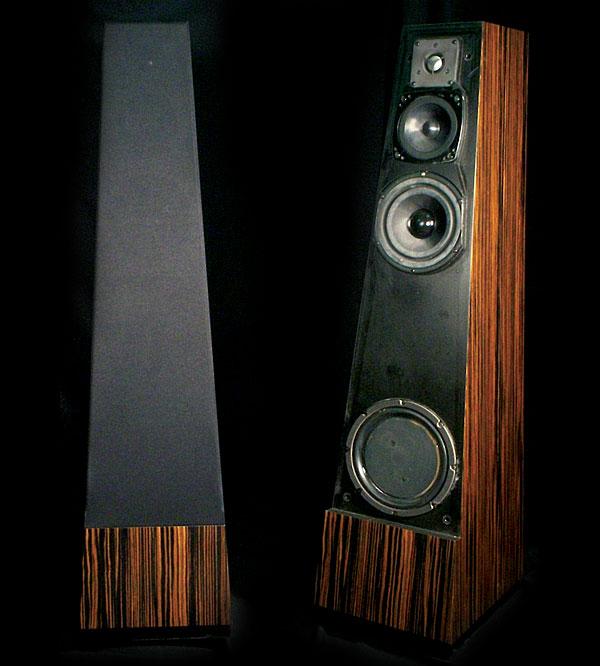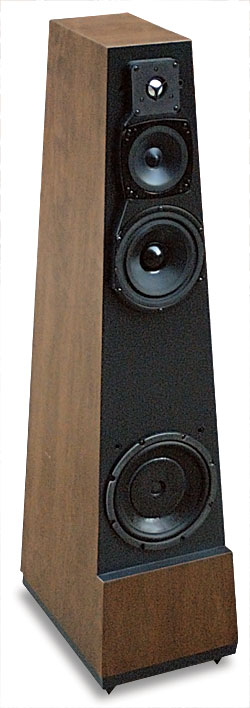| Columns Retired Columns & Blogs |
I noticed more details about the brand of cables used than the brand of drivers used in this "highly recommended" 85dB/w/m shhhpeaker.

But of perhaps equal if not more importance to the commercial success of the Model 2 and its variants—more than 80,000 pairs had been sold by the turn of the century, and the speaker is still available as the 2Ce Signature II—was the fact that Vandersteen had offered the speaker at a price significantly lower than should have been possible for the sound quality on offer: $1125/pair in 1986, and only slightly higher, $1295/pair, in 2000. He managed this by dispensing with the usual wood-veneered enclosure, instead surrounding the speaker's carcass with a black rectangular sock.
And such was the Model 2's performance/price ratio that it wasn't until the introduction, in 1997, of the technically sophisticated Model 5, with its powered subwoofer section, that Vandersteen had a loudspeaker that wasn't undercut by the then-venerable Model 2. The Model 5 also broke with tradition by having a veneered enclosure for its low-frequency drivers, though it continued the minimal-baffle concept for its upper-frequency drivers. Vandersteen's Quatro and Quatro Wood, respectively reviewed by Michael Fremer in July 2006 and Wes Phillips in December 2007, combined a less-expensive development of the Model 5's powered subwoofer with a tweeter/midrange/upper-woofer array mounted on a conventional baffle at the top of a tall enclosure. The Wood had a veneered enclosure; the basic Quatro saved its purchaser money by enclosing an unfinished box in a black cloth sock. However, the Quatros continued the minimal-baffle concept by tapering the enclosure toward its top.
 The next Vandersteen designs were both more and less expensive than the Quatro. The Model 7, reviewed by Michael Fremer in March 2010, took Vandersteen's design ideas to a new level of performance, though at a price: $48,000/pair upward, for which you could purchase 20 pairs of Model 2Ce Signature IIs (which now costs $2395/pair). The Treo, which I listened to in prototype form at the 2011 CES, goes in the other direction. It's conceptually similar to the Quatro Wood, but replaces that speaker's active, equalized bass unit with a conventional 6.5" woofer and an 8" flat-cone subwoofer, both loaded with a 2" port. Whereas the Quatro Wood costs $10,900/pair, the Treo is priced at $5990/pair. Once the Treo was in production, I asked for samples; Richard Vandersteen sent me a pair in fall 2012.
The next Vandersteen designs were both more and less expensive than the Quatro. The Model 7, reviewed by Michael Fremer in March 2010, took Vandersteen's design ideas to a new level of performance, though at a price: $48,000/pair upward, for which you could purchase 20 pairs of Model 2Ce Signature IIs (which now costs $2395/pair). The Treo, which I listened to in prototype form at the 2011 CES, goes in the other direction. It's conceptually similar to the Quatro Wood, but replaces that speaker's active, equalized bass unit with a conventional 6.5" woofer and an 8" flat-cone subwoofer, both loaded with a 2" port. Whereas the Quatro Wood costs $10,900/pair, the Treo is priced at $5990/pair. Once the Treo was in production, I asked for samples; Richard Vandersteen sent me a pair in fall 2012.
The Treo . . .
. . . has the same dimensions as the Quatro Wood—43" high by 10" wide by 15" deep—but weighs 80 lbs, compared to the more expensive speaker's 122 lbs. The enclosure is finished in wooden veneer, but all but the bottom 7" of the front baffle is covered by the substantial black cloth grille. Each of the three upper drive-units stands proud of the baffle on a small subchassis; the grille's frame surrounds each of the diaphragms with a smooth surface to optimize diffraction and minimize reflections of the high frequencies from the baffle edges. Use of the grille is mandatory, therefore.
The tweeter is the same ferrofluid-cooled, hard-anodized, aluminum-alloy dome used in the Quatros and the Model 5. Mounted immediately below it on the gently sloped-back front baffle and crossing over at 5kHz is what appears to be the same 4.5" midrange unit as used in the Quatros: a woven-composite cone and dustcap terminated with a flat surround, and a die-cast chassis with minimal aerodynamic obstruction behind the cone. Mounted immediately below the midrange is the 6.5" upper woofer, which handles frequencies below 900Hz and has a woven-fiber cone and a substantial half-roll rubber surround.
At the base of the baffle section is an 8" subwoofer, covering the range from 36 to 80Hz. This features a shallow carbon-loaded pulp diaphragm to which, over the dustcap, a ring has been glued to add mass. The two woofers are reflex-loaded with a 2"-diameter, downfiring port mounted under the Treo's integral plinth. Two cones screw into the front of the plinth to provide the necessary floor clearance for the port. A third cone screws into the center rear of the plinth, while two outrigger spikes prevent the Treo from tipping over.
The crossover is first-order, with 6dB/octave slopes. Electrical connection is via Vandersteen's traditional terminal strip mounted to a metal plate on the speaker's rear, with one pair of screw-down terminals supplied for the midrange and tweeter, another pair for the two woofers. Richard Vandersteen holds that a terminal strip provides a more secure, more reliable connection. However, the Treo's terminals are too narrow for the chunky spades of my AudioQuest Wild cables. I used Cardas Clear connected to the low-frequency terminals, with Kimber Kable jumpers connecting the upper-frequency drivers.
Overall, the Treo is a good-looking piece of audio furniture, elegantly proportioned.
Listening
The Treos proved relatively straightforward to set up in my room. The primary adjustments I made were to bring the upper- and lower-midrange regions into balance by experimenting with the distance of each speaker from the nearest sidewall. However, the upper midrange remained a little emphasized in absolute terms. This didn't lead to any noticeable coloration, but it undoubtedly aided the Treo's superb clarity.

That information is a few clicks away on the Vandersteen website. I applaud reviewers who don't waste space recounting spec sheets and marketing literature. Providing a link is more than enough.
I have not heard the Treo yet, but the Model 2 Sig turned me into an audiophile. I still clearly remember the day I demoed it 15 years ago. I had no idea that there was such a big difference between speakers or that "inexpensive" speakers could sound that good. It literally brought tears to my eyes when I listened to A Tribute to Jack Johnson in the show room.
(My username is because I'm a fan. I have no link to the company.)

At least some of the drivers are custom or semi-custom and I believe Vandersteen works with Scanspeak (and perhaps others) to create and modify drivers.

I have been looking for the perfect loudspeaker for over 30 years.
I started with some Polk RTA 12 Monitor speakers, then went to Vandersteen 2Ci speakers, then Vandersteen 3 and 3A speakers.
I have gone to hi-fi stores and the CES in Las Vegas untold times looking for something that cost under $10,000 and would be the holy grail; the one that really could come close to flawless reproduction of the live sound, but never could find it.
I heard many excellent speakers, but for me there was always one major flaw of some sort that made them imperfect and overall not equal to my Vandersteen 3A speakers.
I finally became convinced that the Vandersteen Treo would be, if not perfect, an improvement over my 3A speakers that was worthwhile, so I bought a pair.
When I actually hooked them up in my home, I was awe-struck. These are not only much much better than my 3A speakers, they come as close as anything I have ever experienced to being a flawless perfect reproducer of the live musical experience.
I have never heard a speaker that comes so close to perfection, without one single sonic flaw that I can identify in playing classical, jazz, vocal, bluegrass...you name it and it makes it come to life.
My NHT subwoofer adds some bass power and bass extension to the extreme low end, but the Treo is quite capable of very good bass performance on its own. For 80% of my music, the subwoofer is really not needed.
But as far as audible sonic flaws, I can find NONE!! That is a totally new experience for me.
My wife, who was not real convinced that any speaker could be worth $6000, and was more than ready to find some flaws she could criticize, listened for a couple of minutes and got a silly smile on her face and said not a word. She is in love with them. Wife approval factor; off the chart.
These speakers have totally redefined my concept of what ANY speaker is capable of, especially for less than $10,000.

Vandersteen, in his owner's manual and product literature, makes a BIG point of his assertion that these speakers WILL NOT perform at their full potential unless they are bi-wired.
John clearly did not bi-wire the speakers when he tested them.
That seems odd to me and I wonder why he did not go with the manufacturer's recommendation. Surely he has access to some high-quality bi-wire cable sets.
With my Vandersteen 3A speakers and now with my Treo speakers I use eight lengths of Belden #10 102-strand wire with Audioquest gold-plated spade lugs to bi-wire them, and the result is superior sound quality.

I don't quite understand JA's statement in the review about the grills being mandatory due to baffle reflections:
"Each of the three upper drive-units stands proud of the baffle on a small subchassis; the grille's frame surrounds each of the diaphragms with a smooth surface to optimize diffraction and minimize reflections of the high frequencies from the baffle edges. Use of the grille is mandatory, therefore"
Is he saying that he listened with and without and determined this (because it doesn't sound like it). If not, has anyone heard them with/without the grills and reached their own conclusions? A lot of manufacturers claim their speakers sound great with the grills on, but it's rare for them to be right in all respects. There are bound to be trade offs with either scenario, rather than across-the-board improvements.

A lot of manufacturers claim their speakers sound great with the grills on, but it's rare for them to be right in all respects. There are bound to be trade offs with either scenario, rather than across-the-board improvements.
I thought the text of mine that you quoted self-explanatory. Unlike most speakers but like some of the Paradigms, the Treo's grille is an extension of the baffle and provides an essential part of the acoustic loading of the upper-frequency drive-units. The speaker sounds and measures worse without the grille.
John Atkinson
Editor, Stereophile

Ah, thanks! That was, indeed, more explanatory! I also looked more closely at some pictures and the baffle-extending aspect makes sense.

The jury is likely still out on the value of bi-wiring, or even bi-amping, unless very carefully implemented.
https://www.audioholics.com/audio-video-cables/bi-wiring-from-amplifier-to-loudspeaker But the Treo manual clearly claims that bi-wiring the Treo will always sound better than not doing so.
https://www.vandersteen.com//media/files/Manuals/TREO%20CT%208-19-22%20.pdf
And because doing so would have hardly been a problem for JA, I can't understand why he didn't do so. Surely, Richard Vandersteen would have betted that JA's very extensive listening tests would have had the Treo shining far more than JA had experienced.
Also, I have just emailed Richard Vandersteen about submitting the new Treo CT for review here. Please make this review happen this year-AND please don't forget to bi-wire them!!